

Compact Muon Solenoid
LHC, CERN
| CMS-PAS-BPH-23-008 | ||
| Search for rare charm decays into two muons | ||
| CMS Collaboration | ||
| 28 July 2024 | ||
| Abstract: A search for the rare decay D0→μ+μ− was conducted using √s= 13.6 TeV proton-proton collision data collected by the CMS experiment during the 2022-2023 operation of the CERN LHC, with an integrated luminosity of 64.5 fb−1. The search exploits a new high-rate trigger that records events with two muons with transverse momenta as low as 4 and 3 GeV. Rare decays of the charm quark, which are less explored than rare bottom quark decays, offer a unique way to probe for new physics effects beyond the reach of modern colliders. No significant excess above the expected background was observed, leading to an upper limit of B(D0→μ+μ−)< 2.6 × 10−9 at the 95% confidence level. This is the most sensitive measurement to date, imposing additional constraints on new physics models. | ||
| Links: CDS record (PDF) ; CADI line (restricted) ; | ||
| Figures | |

png pdf |
Figure 1:
Dipion invariant mass mππ (left) and D∗-D0 mass difference Δm (right) from the reconstructed candidates from zero bias samples after MVAD selection. |
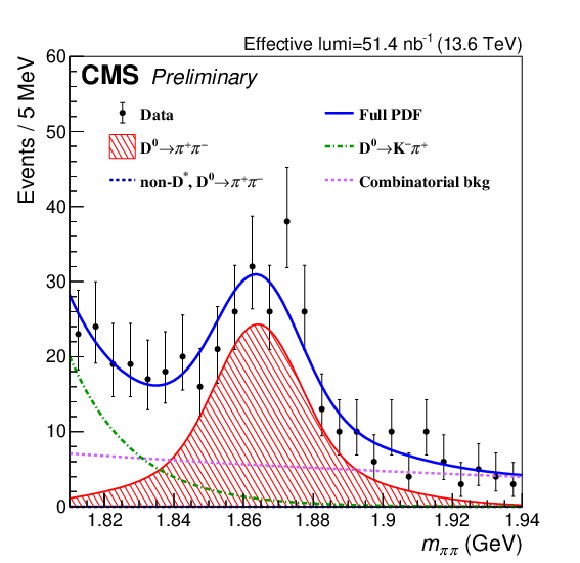
png pdf |
Figure 1-a:
Dipion invariant mass mππ (left) and D∗-D0 mass difference Δm (right) from the reconstructed candidates from zero bias samples after MVAD selection. |

png pdf |
Figure 1-b:
Dipion invariant mass mππ (left) and D∗-D0 mass difference Δm (right) from the reconstructed candidates from zero bias samples after MVAD selection. |
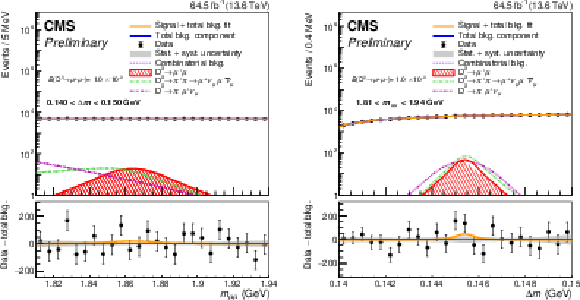
png pdf |
Figure 2:
The projection of mμμ (left) and Δm (right) of the fit in the full mμμ and Δm range. The bottom panel shows the data and the fit result after subtraction of the total background component. The grey error band represents the statistical and systematic uncertainties of the total background component. |

png pdf |
Figure 2-a:
The projection of mμμ (left) and Δm (right) of the fit in the full mμμ and Δm range. The bottom panel shows the data and the fit result after subtraction of the total background component. The grey error band represents the statistical and systematic uncertainties of the total background component. |

png pdf |
Figure 2-b:
The projection of mμμ (left) and Δm (right) of the fit in the full mμμ and Δm range. The bottom panel shows the data and the fit result after subtraction of the total background component. The grey error band represents the statistical and systematic uncertainties of the total background component. |

png pdf |
Figure 3:
The projection of mμμ (left) and Δm (right) of the fit with requirements 0.145 <Δm< 0.146 GeV and 1.84 <mμμ< 1.89 GeV, respectively. The bottom panel shows the data and the fit result after subtraction of the total background component. The grey error band represents the statistical and systematic uncertainties of the total background component. |
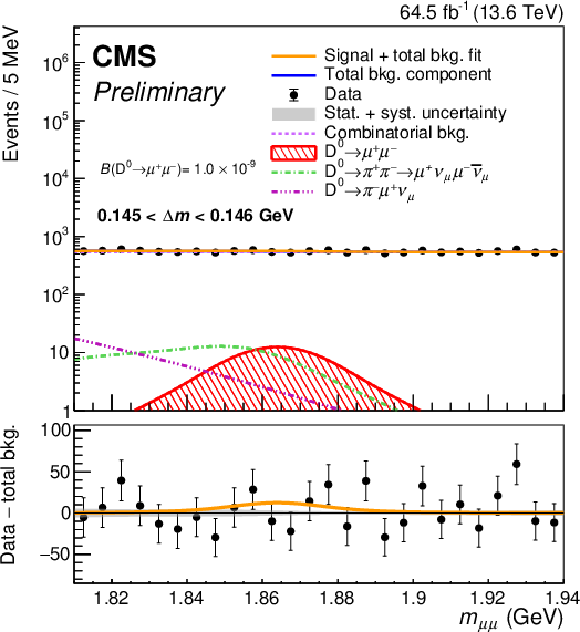
png pdf |
Figure 3-a:
The projection of mμμ (left) and Δm (right) of the fit with requirements 0.145 <Δm< 0.146 GeV and 1.84 <mμμ< 1.89 GeV, respectively. The bottom panel shows the data and the fit result after subtraction of the total background component. The grey error band represents the statistical and systematic uncertainties of the total background component. |

png pdf |
Figure 3-b:
The projection of mμμ (left) and Δm (right) of the fit with requirements 0.145 <Δm< 0.146 GeV and 1.84 <mμμ< 1.89 GeV, respectively. The bottom panel shows the data and the fit result after subtraction of the total background component. The grey error band represents the statistical and systematic uncertainties of the total background component. |
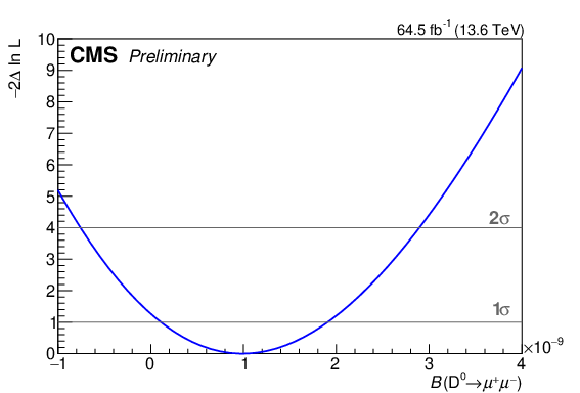
png pdf |
Figure 4:
The profile likelihood scan as a function of D0→μ+μ− decay branching fraction. |
| Tables | |

png pdf |
Table 1:
Fitted yields with zero bias events after MVAD selection. |
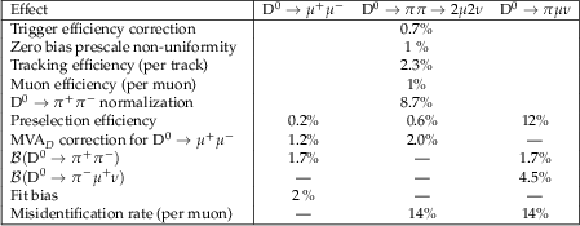
png pdf |
Table 2:
Summary of systematic uncertainties for the D0→μ+μ− branching ratio measurement. |

png pdf |
Table 3:
The expected event yields for signal, the combinatorial background, the peaking background, and the semileptonic background are summarized (post-fit). The total expected and observed event yields are given in Total and Data column, respectively. The subrange is in one dimension with a full range in the other dimension. |
| Summary |
| The measurement of the branching fraction (B) of the D0→μ+μ− decay, based on a data set of proton-proton collisions at √s= 13.6 TeV collected by the CMS experiment corresponding to an integrated luminosity of 64.5 fb−1, has been presented. The branching fraction is measured using the cascade decay D∗+→D0π+, D0→μ+μ− with the D0→π+π− decay mode as the normalization channel, considering both prompt and non-prompt D0 meson production. No significant excess above the background expectation was observed and an upper limit on the branching fraction has been set to be B(D0→μ+μ−) < 2.6\times10^-9at95 \mathrm{D^0}\to\mu^{+}\mu^{-} branchingfractionisfoundtobe \mathcal{B}(\mathrm{D^0}\to\mu^{+}\mu^{-}) = (1.0 \pm 0.9)\times10^{-9}$. The measurement is the most sensitive to date, representing a 35% improvement over the current best measurement [23]. This measurement provides the most stringent limit on flavor-changing neutral currents in the charm sector, setting additional constraints on new physics models that modify the decay branching fraction of D0→μ+μ−. The analysis is the first measurement at CMS using the newly developed low-mass double muon parking trigger [24]. It also marks the first publication on the D0→μ+μ− branching fraction measurement at CMS, made possible by the enriched dimuon events collected by this innovative trigger. |
| References | ||||
| 1 | CMS Collaboration | Angular analysis of the decay B0→K∗0μ+μ− from pp collisions at √s= 8 TeV | PLB 753 (2016) 424 | CMS-BPH-13-010 1507.08126 |
| 2 | CMS Collaboration | Measurement of angular parameters from the decay B0→K∗0μ+μ− in proton-proton collisions at √s= 8 TeV | PLB 781 (2018) 517 | CMS-BPH-15-008 1710.02846 |
| 3 | CMS Collaboration | Measurement of properties of B0s→μ+μ− decays and search for B0→μ+μ− with the CMS experiment | JHEP 04 (2020) 188 | CMS-BPH-16-004 1910.12127 |
| 4 | ATLAS, CMS and LHCb Collaborations | Combination of the ATLAS, CMS and LHCb results on the B0s→μ+μ− decays | Physics Analysis Summary, LHCb-CONF-2020-002, ATLAS-CONF-2020-049, 2020 CMS-PAS-BPH-20-003 |
CMS-PAS-BPH-20-003 |
| 5 | CMS Collaboration | Measurement of the B0s→μ+μ− decay properties and search for the B0→μ+μ− decay in proton-proton collisions at √s = 13 TeV | PLB 842 (2023) 137955 | CMS-BPH-21-006 2212.10311 |
| 6 | LHCb Collaboration | Angular analysis of the B+→K∗+μ+μ− Decay | PRL 126 (2021) 161802 | 2012.13241 |
| 7 | LHCb Collaboration | Measurement of CP-Averaged observables in the B0→K∗0μ+μ− Decay | PRL 125 (2020) 011802 | 2003.04831 |
| 8 | LHCb Collaboration | Angular analysis of the rare decay B0s→ϕμ+μ− | JHEP 11 (2021) 043 | 2107.13428 |
| 9 | LHCb Collaboration | Branching Fraction Measurements of the Rare B0s→ϕμ+μ− and B0s→f′2(1525)μ+μ− Decays | PRL 127 (2021) 151801 | 2105.14007 |
| 10 | LHCb Collaboration | Measurement of the B0s→μ+μ− branching fraction and effective lifetime and search for B0→μ+μ− decays | PRL 118 (2017) 191801 | 1703.05747 |
| 11 | LHCb Collaboration | Measurement of the B0s→μ+μ− decay properties and search for the B0→μ+μ− and B0s→μ+μ−γ decays | PRD 105 (2022) 012010 | 2108.09283 |
| 12 | LHCb Collaboration | Analysis of neutral B-meson decays into two muons | PRL 128 (2022) 041801 | 2108.09284 |
| 13 | ATLAS Collaboration | Angular analysis of B0→K∗μ+μ− decays in pp collisions at √s= 8TeV with the ATLAS detector | JHEP 10 (2018) 47 | 1805.04000 |
| 14 | ATLAS Collaboration | Study of the rare decays of B0s and B0 mesons into muon pairs using data collected during 2015 and 2016 with the ATLAS detector | JHEP 04 (2019) 098 | 1812.03017 |
| 15 | CMS and LHCb Collaboration | Observation of the rare B0s→μ+μ− decay from the combined analysis of CMS and LHCb data | Nature 522 (2015) 68 | CMS-BPH-13-007 1411.4413 |
| 16 | BABAR Collaboration | Measurement of angular asymmetries in the decays B→K∗ℓ+ℓ− | PRD 93 (2016) 052015 | 1508.07960 |
| 17 | Belle Collaboration | Measurement of the Differential Branching Fraction and Forward-Backward Asymmetry for B→K∗ℓ+ℓ− | PRL 103 (2009) 171801 | 0904.0770 |
| 18 | Belle Collaboration | Lepton-Flavor-Dependent Angular Analysis of B→K∗ℓ+ℓ− | PRL 118 (2017) 111801 | 1612.05014 |
| 19 | CDF Collaboration | Measurements of the Angular Distributions in the Decays B→K(∗)μ+μ− at CDF | PRL 108 (2012) 081807 | 1108.0695 |
| 20 | E. Golowich, J. Hewett, S. Pakvasa, and A. A. Petrov | Relating D0−¯D0 mixing and D0→μ+μ− with new physics | PRD 79 (2009) 114030 | 0903.2830 |
| 21 | S. Fajfer and N. Košnik | Leptoquarks in flavor changing neutral current charm decays | PRD 79 (2009) 017502 | 0810.4858 |
| 22 | G. Burdman, E. Golowich, J. L. Hewett, and S. Pakvasa | Rare charm decays in the standard model and beyond | PRD 66 (2002) 014009 | hep-ph/0112235 |
| 23 | LHCb Collaboration | Search for rare decays of D0 mesons into two muons | PRL 131 (2023) 041804 | 2212.11203 |
| 24 | CMS Collaboration | Enriching the physics program of the CMS experiment via data scouting and data parking | link | CMS-EXO-23-007 2403.16134 |
| 25 | LHCb Collaboration | Measurements of prompt charm production cross-sections in pp collisions at √s= 13 TeV | JHEP 03 (2016) 159 | 1510.01707 |
| 26 | CMS Collaboration | The CMS experiment at the CERN LHC | JINST 3 (2008) S08004 | |
| 27 | CMS Collaboration | Track impact parameter resolution for the full pseudorapidity coverage in the 2017 dataset with the CMS Phase-1 pixel detector | CMS Detector Performance Report CMS-DP-2020-049, 2020 CDS |
|
| 28 | CMS Collaboration | Performance of the CMS muon detector and muon reconstruction with proton-proton collisions at √s= 13 TeV | JINST 13 (2018) P06015 | CMS-MUO-16-001 1804.04528 |
| 29 | CMS Collaboration | Performance of the CMS Level-1 trigger in proton-proton collisions at √s= 13 TeV | JINST 15 (2020) P10017 | CMS-TRG-17-001 2006.10165 |
| 30 | CMS Collaboration | The CMS trigger system | JINST 12 (2017) P01020 | CMS-TRG-12-001 1609.02366 |
| 31 | T. Sjöstrand et al. | An introduction to PYTHIA 8.2 | Comput. Phys. Commun. 191 (2015) 159 | 1410.3012 |
| 32 | CMS Collaboration | Extraction and validation of a new set of CMS PYTHIA8 tunes from underlying-event measurements | EPJC 80 (2020) 4 | CMS-GEN-17-001 1903.12179 |
| 33 | GEANT4 Collaboration | GEANT 4---a simulation toolkit | NIM A 506 (2003) 250 | |
| 34 | D. J. Lange | The EvtGen particle decay simulation package | NIM A 462 (2001) 152 | |
| 35 | N. Davidson, T. Przedzinski, and Z. Was | PHOTOS interface in C++: technical and physics documentation | Comput. Phys. Commun. 199 (2016) 86 | 1011.0937 |
| 36 | CMS Collaboration | Description and performance of track and primary-vertex reconstruction with the CMS tracker | JINST 9 (2014) P10009 | CMS-TRK-11-001 1405.6569 |
| 37 | K. Prokofiev and T. Speer | A kinematic and a decay chain reconstruction library | Prepared for Computing in High-Energy Physics (CHEP '04), Interlaken, Switzerland, 2004 | |
| 38 | T. Chen and C. Guestrin | XGBoost: A scalable tree boosting system | in Proceedings of the 22nd ACM SIGKDD International Conference on Knowledge Discovery and Data Mining, KDD '16, New York, 2016 link |
|
| 39 | W. Verkerke and D. P. Kirkby | The RooFit toolkit for data modeling | eConf C0303241 (2003) MOLT007 | physics/0306116 |
| 40 | LHCb Collaboration | Search for the rare decay D0→μ+μ− | PLB 725 (2013) 15 | 2106.03744 |
| 41 | CMS Collaboration | The CMS statistical analysis and combination tool: COMBINE | link | CMS-CAT-23-001 2404.06614 |
| 42 | P. D. Dauncey, M. Kenzie, N. Wardle, and G. J. Davies | Handling uncertainties in background shapes: the discrete profiling method | JINST 10 (2015) P04015 | 1408.6865 |
| 43 | CMS Collaboration | Tracking performances for charged pions with Run2 legacy data | CMS Detector Performance Report CMS-DP-2022-012, 2022 CDS |
|

|
Compact Muon Solenoid LHC, CERN |

|

|

|

|

|

|